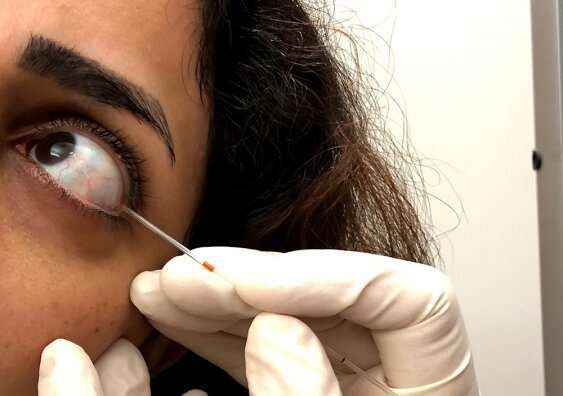Marker in tear samples could detect diabetes complication

You've heard of blood tests and stool samples. Tear samples might be the next screening method to enter your doctor's office, a new study from UNSW Sydney suggests.
Tear-testing may be the future of screening for diabetic peripheral neuropathy, a debilitating condition that affects people with diabetes, new research from UNSW Sydney suggests.
The study, recently published in The Ocular Surface, is the first to show that peripheral nerve damage—often the earliest sign of the condition—can be traced in tear film.
"We found that people with type 1 diabetic peripheral neuropathy—which can result in recurring ulcers of the feet and in severe cases require amputation—have reduced levels of a protein known as 'substance P' in their tear film," says Dr. Maria Markoulli, senior author of the study.
"119,000 Australians have type 1 diabetes. In the future, they may be able to have a quick tear sample collected either at their optometrist, the chemist, GP or endocrinologist, and be told whether they are at risk."
Peripheral neuropathy is the most common complication of diabetes and affects almost 50% of diabetics. It occurs when chronically high blood sugar damages the nerves connecting the brain and spinal cord to the rest of the body.
Symptoms include pain, numbness, imbalance, weakness, pins and needles, and recurring foot ulcers.
While nerve damage cannot be reversed, early detection can help patients better manage the condition and prevent further complications. However, current early testing options are limited to invasive examinations, such as skin biopsies.
"Peripheral neuropathy is notoriously difficult to detect early on and requires specialty training," says Dr. Markoulli.
"What we're proposing with this method is something that will be done quickly, non-invasively, and potentially could be done even by a non-specialist."
The researchers tested the concentration of two proteins (called neuropeptides) in the tear film of people with type 1 and type 2 diabetes compared to control groups. The study consisted of almost 100 participants.
While the researchers found that those with type 1 diabetic peripheral neuropathy had less 'substance P' protein in their tear film, the results did not suggest that type 2 diabetes have the same biomarkers. "This is perhaps because these diseases have different pathologies and risk factors," writes Ph.D. candidate and lead author of the study, Mr Shyam Sunder Tummanapalli.
"It tells us that the two disease processes are quite different," says Dr. Markoulli, who is eager to expand the study to determine specific changes in type 2 diabetes. "What proteins change there? Is there also a link to the tear film and peripheral neuropathy?"
While the results are promising for those with type 1 diabetes, further study is required before tear testing becomes available clinically. In particular, the researchers hope to study substance P loss over time according to varying severities of peripheral neuropathy.
More information: Shyam Sunder Tummanapalli et al. Tear film substance P: A potential biomarker for diabetic peripheral neuropathy, The Ocular Surface (2019). DOI: 10.1016/j.jtos.2019.08.010


















